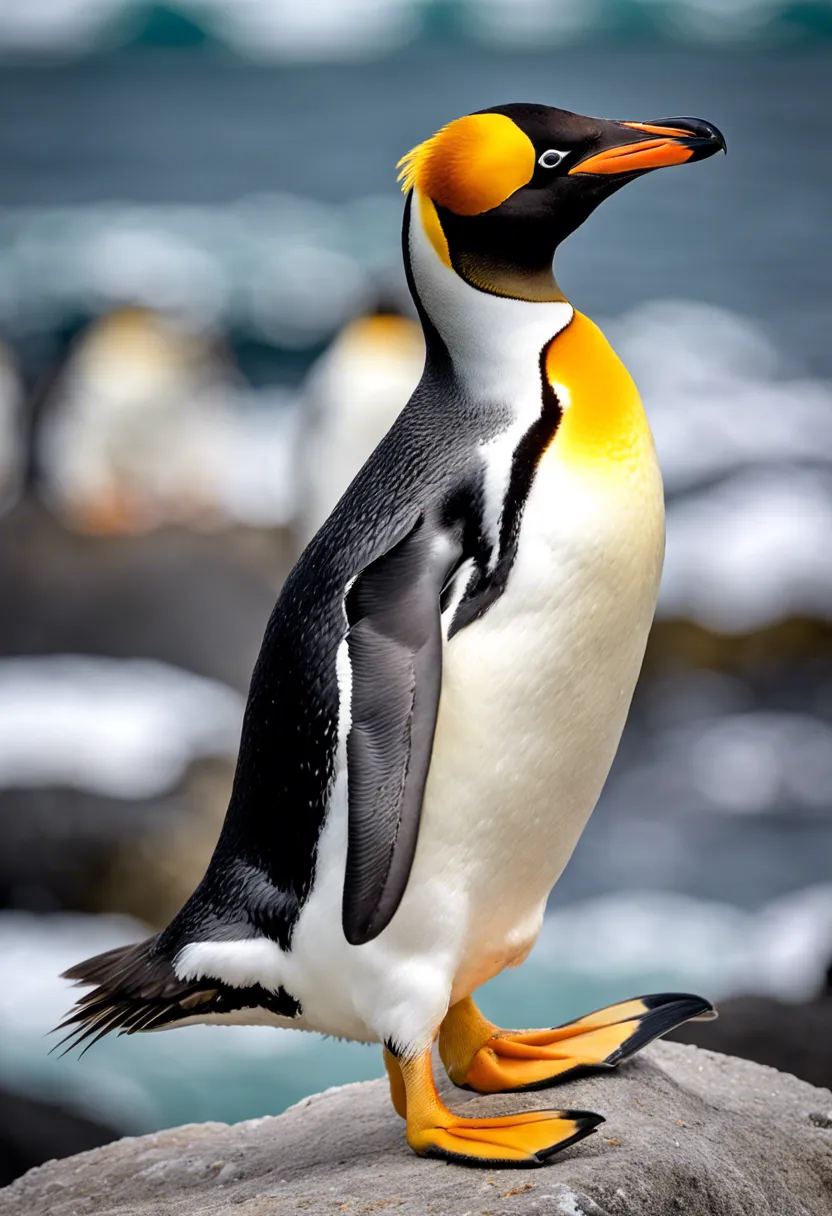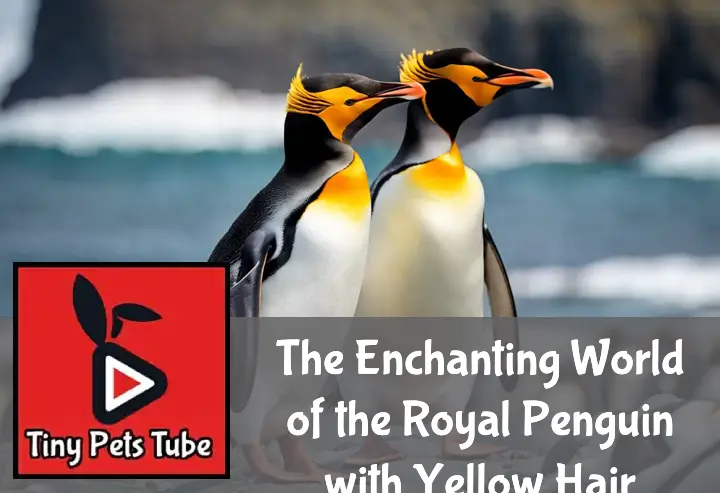Ever stumbled upon a penguin with a golden crown? Well, meet the Royal Penguin with Yellow Hair. These regal fellas are quite the sight, sporting yellow feathers that look like they’ve been dipped in sunshine.
But don’t let their royal demeanor fool you. They’re as playful and quirky as they come! So buckle up, folks. We’re about to dive into the enchanting world of these gilded seabirds. Keep reading about The Enchanting World of the Royal Penguin with Yellow Hair!
Key Takeaways
- Royal Penguins are unique due to their yellow hair-like feathers.
- They are found mainly on Macquarie Island, between New Zealand and Antarctica.
- The yellow hair is a result of carotenoid pigments in their diet.
- Their vibrant color helps them attract mates during breeding season.
- Despite their captivating appearance, they face threats from climate change and overfishing.

What is the Royal Penguin with Yellow Hair?
Welcome to the world of Royal Penguin with Yellow Hair, a fascinating member of the Antarctic wildlife. This unique penguin species, known for its vibrant yellow hair, calls the chilly habitats of Antarctica home. It’s not just another bird in the flock; it’s got some real standout features that set it apart from its tuxedo-clad cousins.
Understanding the Species
Diving into Royal Penguin facts, we find that this bird belongs to a specific taxonomy. Its scientific name, Eudyptes schlegeli, might sound like a mouthful, but it’s just fancy talk for “cool bird with yellow hair”. These birds are part and parcel of Sub-Antarctic wildlife, preferring islands with cooler climates.
The habitat of Royal Penguins is quite specific. They’re found mainly on Macquarie Island, an isolated spot between New Zealand and Antarctica. That’s right! These birds have their own private island getaway. Talk about living the dream!
When comparing penguin species differences, our yellow-haired friends stand out quite literally. Unlike their black and white counterparts, these guys sport a flashy crest of yellow feathers on their heads. It’s like they’re always ready for a party!
Unique Characteristics of the Royal Penguin with Yellow Hair
Now let’s talk about what makes this bird so special – its yellow plumage. The golden crest running from its bill up over its head gives it an almost royal appearance – hence the name ‘Royal Penguin’. It’s like nature’s own crown!
The diet of Royal Penguins is pretty much seafood galore! They love snacking on krill and small fish – essentially anything they can catch in their beaks while swimming around in those icy waters.
Social behavior in penguins is also worth mentioning here. These birds are super social creatures who love hanging out in large colonies. You could say they’re the life of the party in the penguin world!
Lastly, their adaptations for survival are truly remarkable. Their yellow hair isn’t just for show – it helps them blend into their environment and avoid predators. So, not only are they stylish, but they’re also smart!
Where Can You Find the Royal Penguin with Yellow Hair?
Well, let’s dive right into their world, shall we?
Natural Habitat and Geographical Distribution
The royal penguin habitat is quite unique. These fellas are found mainly on the Sub-Antarctic islands, particularly Macquarie Island. Now, you might be thinking, “What’s so special about this island?” Well, it’s a hotspot for penguin breeding grounds. It’s like their own little love island!
But don’t think they’re just lounging around all day. These birds are part of the bustling Southern Ocean ecosystems. They’re real jet-setters too! Their wildlife geographical range extends far and wide across these icy waters.
Impact of Climate on their Habitat
Now here comes the not-so-fun part – climate change. It’s causing some serious issues for our yellow-haired friends. Global warming effects aren’t just about hotter summers and milder winters. For these penguins, it means a drastic shift in their living conditions.
Antarctic ice melt impact is no joke either. As ice melts at faster rates, it disrupts the penguin food sources, making it harder for them to find meals. Imagine having your fridge slowly empty out without any grocery stores nearby!
And if that wasn’t enough, habitat loss due to climate change is another biggie. Environmental threats to penguins are real and they’re happening right now. So next time you think about climate change, remember our royal pals with the yellow hair!

Why Does the Royal Penguin have Yellow Hair?

Well, it’s all about genetics and survival, mate! The Royal Penguin with Yellow Hair is a sight to behold. Their vibrant plumage isn’t just for show; it plays a crucial role in their mating rituals and survival.
The Role of Genetics in Coloration
You see, penguin genetics are quite fascinating. They’re responsible for the royal penguin yellow hair, thanks to specific coloration genes. These genes are like tiny artists painting each feather with unique hues.
Now, these genes don’t work alone. They’re influenced by factors like diet and environment which contribute to the final masterpiece – the plumage color development. It’s a complex process that showcases the beauty of nature and genetic diversity.
The result? A stunning display of genetic diversity in penguins, making each one unique. This isn’t just about aesthetics though; these hereditary traits play a significant role in their survival.
Significance of Yellow Hair in Mating and Survival
Speaking of survival, let’s talk about love – penguin style! In the world of royal penguins, having yellow hair is like wearing designer threads at a high-end party. It makes them irresistible during the mating rituals of royal penguins.
But it’s not all about looking good for your date. The yellow plumage also serves as an excellent camouflage against predators or harsh environmental conditions. It’s like their very own superhero costume!
This clever use of coloration is part of their survival strategies in penguins. It helps them blend into their surroundings, deterring potential predators while also helping them adapt to various environmental challenges.
So next time you spot a Royal Penguin with Yellow Hair, remember they’re not just fashionable; they’re survivors!
How Does the Royal Penguin with Yellow Hair Behave?
The Royal Penguin with Yellow Hair is a fascinating creature, full of quirks and unique behaviors. From their social dynamics to their communication methods, these penguins are far from ordinary.
Social Structure and Behavior
When it comes to the social life of a Royal Penguin, hierarchy plays a significant role. These penguins have a communal lifestyle where every bird has its place. This structure influences everything from mating rituals to nesting habits, ensuring order within the colony.
In terms of parenting techniques, Royal Penguins are quite hands-on. Both parents share responsibilities in raising their chicks, which is rare in the animal kingdom. They also interact with other species, but they’re not exactly social butterflies – more like awkward party guests who keep to themselves.
Communication Methods Amongst Penguins
Communication among Royal Penguins is an intricate dance of vocalizations and body language. They use different calls for various situations – whether it’s attracting a mate or warning others about potential threats.
Body language is another crucial part of penguin communication. A simple flipper wave or head bob can convey messages that words (or squawks) can’t. And when it comes to territorial disputes or mating rituals, these birds aren’t shy about making themselves heard and seen.
So there you have it – the complex world of Royal Penguin behavior isn’t just black and white!
What Threats does the Royal Penguin with Yellow Hair Face?
The Royal Penguin with Yellow Hair faces a myriad of threats, both natural and human-induced. These challenges pose significant risks to their survival and conservation status.
Natural Predators and Threats
When it comes to penguin natural predators, seals top the list. They’re like the boogeymen of the penguin world, lurking in the icy waters waiting for an unsuspecting meal. This seal predation on penguins can have a substantial impact on royal penguin populations.
But it’s not just seals these little fellas need to worry about. Larger birds also pose a threat, swooping down from above in search of an easy snack. These bird threats to penguins add another layer of danger to their already perilous existence.
Despite these threats, there are wildlife protection measures in place. Conservationists are working tirelessly to understand predator-prey dynamics and develop strategies that ensure our feathered friends’ survival.
Human Activities Impacting Their Survival
Humans, unfortunately, also play a role in threatening the survival of the Royal Penguin with Yellow Hair. Pollution is one such human impact on penguins that’s causing serious concern. From oil spills to plastic waste, our actions are turning their habitats into toxic wastelands.
Fishing practices too have a detrimental effect on these endangered penguins. Overfishing depletes their food sources while fishing nets often ensnare them, leading to tragic consequences.
And then there’s climate change – arguably the biggest threat of all. The effects of climate change on species like our yellow-haired friends are profound, disrupting their breeding patterns and shrinking their habitats.
But it’s not all doom and gloom! There are ongoing conservation strategies for penguins aimed at mitigating these impacts. From sustainable fishing practices to pollution control efforts, we’re fighting back against these threats to ensure the survival of these enchanting creatures.
Conservation Efforts for the Royal Penguin with Yellow Hair
The fight to conserve the Royal Penguin with Yellow Hair is a multifaceted one, involving a range of strategies from habitat protection to public education. It’s a team effort, involving governments, organizations, and individuals alike.
Current Conservation Measures
Governments and organizations worldwide have rolled up their sleeves in the battle for royal penguin conservation. One of the key measures has been habitat protection initiatives. These are designed to safeguard the natural environments where these penguins thrive.
Another significant measure is the implementation of strict anti-poaching laws. These laws aim to deter illegal hunting and trading of these endangered species. They’re enforced by dedicated wildlife officers who patrol penguin habitats regularly.
Breeding programs also play an essential role in boosting the population of this unique bird. In such programs, experts provide a safe environment for breeding and rearing chicks until they’re ready for release into the wild.
Wildlife sanctuary efforts offer another layer of protection. Sanctuaries serve as safe havens where these penguins can live without fear of human interference or predation.
Finally, international conservation agreements ensure that countries work together in protecting this species. Through these agreements, nations commit to implementing and enforcing wildlife preservation strategies that benefit our feathered friends.
How Can Individuals Contribute to Conservation?
But it’s not just about what governments and organizations can do – individuals have a crucial role too! By making eco-friendly lifestyle choices, we can reduce our environmental impact and help protect habitats. This could be as simple as reducing waste or choosing sustainable products.
Donations to wildlife charities also make a big difference. These funds support everything from research to rescue missions, helping ensure the survival of this majestic creature.
There are also plenty of conservation volunteering opportunities out there! Whether it’s assisting with field research or helping maintain protected areas, every bit helps.
Sustainable tourism practices are another way to contribute. By choosing eco-friendly travel options and respecting wildlife during our adventures, we can ensure that these penguins continue to have a safe home.
Lastly, becoming an environmental advocate can have a significant impact. By spreading awareness about the Royal Penguin with Yellow Hair and the importance of conservation, we can inspire others to join the cause too!

To Wrap Up
In the spirit of brevity, the Royal Penguin with Yellow Hair is like that eccentric uncle at family reunions – unique, captivating and full of surprises. We’ve dipped our toes into their fascinating world, but there’s a whole ocean left to explore.
So why not dive in? Let’s keep learning about these yellow-haired rockstars of the penguin world and remember: Life’s too short to ignore the enchanting!


